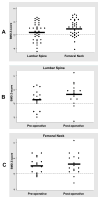Effects of Cushing disease on bone mineral density in a pediatric population
- PMID: 20223476
- PMCID: PMC2875346
- DOI: 10.1016/j.jpeds.2009.12.027
Effects of Cushing disease on bone mineral density in a pediatric population
Abstract
Objective: To evaluate bone mineral density (BMD) in children with Cushing disease before and after transphenoidal surgery (TSS).
Study design: Hologic dual-energy x-ray absorptiometry (DXA) scans of 35 children with Cushing disease were analyzed retrospectively. Sixteen of the 35 patients had follow-up DXA scans performed 13 to 18 months after TSS. BMD and bone mineral apparent density (BMAD) for lumbar spine (LS) L1 to L4 and femoral neck (FN) were calculated.
Results: Preoperatively, 38% and 23% of patients had osteopenia of the LS and FN, respectively. Both BMD and BMAD Z-scores of the LS were worse than those for the FN (-1.60 +/- 1.37 versus -1.04 +/- 1.19, P = .003), and (-1.90 +/- 1.49 versus -0.06 +/- 1.90, P < .001); postoperative improvement in BMD and BMAD were more pronounced in LS than in the FN (0.84 +/- 0.88 versus 0.15 +/- 0.62, P<.001; and 0.73 +/- 1.13 versus -0.26 +/- 1.21, P = .015). Pubertal stage, cortisol levels, and length of disease had no effect on BMD.
Conclusions: In children with Cushing disease, vertebral BMD was more severely affected than femoral BMD and this effect was independent of degree or duration of hypercortisolism. BMD for the LS improved significantly after TSS; osteopenia in this group may be reversible.
Published by Mosby, Inc.
Conflict of interest statement
The authors declare no conflicts of interest.
Figures


Similar articles
-
Individualized evaluation of lumbar bone mineral density and bone mineral apparent density in children and adolescents.Arch Osteoporos. 2018 Oct 29;13(1):117. doi: 10.1007/s11657-018-0532-7. Arch Osteoporos. 2018. PMID: 30374788
-
Differences in prevalence of reduced and low bone mineral density between lumbar spine and femoral neck in peritoneal dialysis patients using dual-energy X-ray absorptiometry (DXA).Perit Dial Int. 2023 Jul;43(4):334-338. doi: 10.1177/08968608221146867. Epub 2023 Jan 10. Perit Dial Int. 2023. PMID: 36627766
-
Bone loss is more severe in primary adrenal than in pituitary-dependent Cushing's syndrome.Osteoporos Int. 2004 Nov;15(11):855-61. doi: 10.1007/s00198-004-1616-3. Epub 2004 Mar 18. Osteoporos Int. 2004. PMID: 15034643
-
Bone mineral density in children and young adults with neurofibromatosis type 1.Endocr Relat Cancer. 2012 Nov 19;19(6):817-25. doi: 10.1530/ERC-12-0293. Print 2012 Dec. Endocr Relat Cancer. 2012. PMID: 23089139 Free PMC article.
-
Bone Mineral Density Improvement After Resolution of Endogenous Cushing Syndrome: A Systematic Review and Meta-Analysis.Endocr Pract. 2025 Mar;31(3):345-351. doi: 10.1016/j.eprac.2024.12.009. Epub 2024 Dec 15. Endocr Pract. 2025. PMID: 39689783
Cited by
-
Paediatric Cushing's disease: Epidemiology, pathogenesis, clinical management and outcome.Rev Endocr Metab Disord. 2021 Dec;22(4):817-835. doi: 10.1007/s11154-021-09626-4. Epub 2021 Jan 30. Rev Endocr Metab Disord. 2021. PMID: 33515368 Free PMC article. Review.
-
Increased longevity due to sexual activity in mole-rats is associated with transcriptional changes in the HPA stress axis.Elife. 2021 Mar 16;10:e57843. doi: 10.7554/eLife.57843. Elife. 2021. PMID: 33724179 Free PMC article.
-
Glucocorticoid-induced osteoporosis: pathophysiological role of GH/IGF-I and PTH/VITAMIN D axes, treatment options and guidelines.Endocrine. 2016 Dec;54(3):603-611. doi: 10.1007/s12020-016-1146-8. Epub 2016 Oct 20. Endocrine. 2016. PMID: 27766553
-
Adrenal hyperplasias in childhood: An update.Front Endocrinol (Lausanne). 2022 Aug 3;13:937793. doi: 10.3389/fendo.2022.937793. eCollection 2022. Front Endocrinol (Lausanne). 2022. PMID: 35992119 Free PMC article. Review.
-
Cushing's Syndrome in Pediatrics: An Update.Endocrinol Metab Clin North Am. 2018 Jun;47(2):451-462. doi: 10.1016/j.ecl.2018.02.008. Endocrinol Metab Clin North Am. 2018. PMID: 29754644 Free PMC article. Review.
References
-
- Magiakou MA, Mastorakos G, Oldfield EH, Gomez MT, Doppman JL, Cutler GB, Jr, et al. Cushing’s syndrome in children and adolescents. Presentation, diagnosis, and therapy. N Engl J Med. 1994;331:629–636. - PubMed
-
- Futo L, Toke J, Patocs A, Szappanos A, Varga I, Glaz E, et al. Skeletal differences in bone mineral area and content before and after cure of endogenous Cushing’s syndrome. Osteoporos Int. 2008;19:941–949. - PubMed
-
- Godang K, Ueland T, Bollerslev J. Decreased bone area, bone mineral content, formative markers, and increased bone resorptive markers in endogenous Cushing’s syndrome. Eur J Endocrinol. 1999;141:126–131. - PubMed
-
- Hermus AR, Smals AG, Swinkels LM, Huysmans DA, Pieters GF, Sweep CF, et al. Bone mineral density and bone turnover before and after surgical cure of Cushing’s syndrome. J Clin Endocrinol Metab. 1995;80:2859–2865. - PubMed
-
- Kawamata A, Iihara M, Okamoto T, Obara T. Bone mineral density before and after surgical cure of Cushing’s syndrome due to adrenocortical adenoma: prospective study. World J Surg. 2008;32:890–896. - PubMed
Publication types
MeSH terms
Substances
Grants and funding
LinkOut - more resources
Full Text Sources
Medical
Miscellaneous

